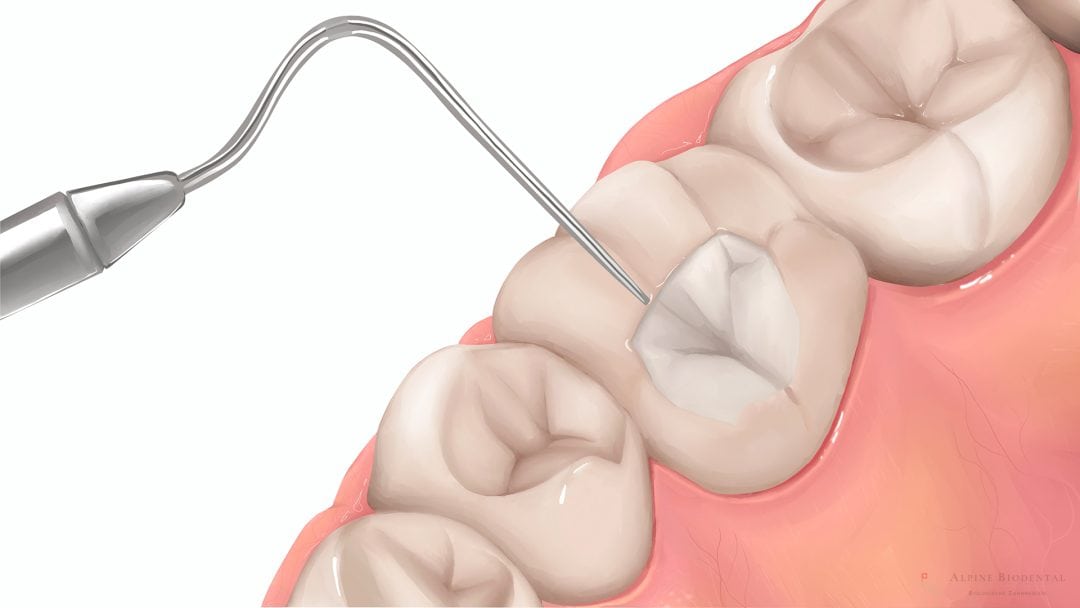Dental Fillings

Dental fillings are materials inserted into the tooth to replace lost parts. In the past, outdated terms like “seal” or “tooth seal” were used.
The main reasons for a dental filling are cavities and old fillings that need replacement.
The most common dental fillings are composite (plastic) fillings and ceramic fillings, which have replaced the previous amalgam fillings.
At Alpine BioDental, we use high-quality composite fillings and health-compatible, durable ceramic fillings.
Reasons for Dental Fillings
A dental filling is always required if the tooth has a defect that needs to be stably replaced with a suitable material. The aim is always the anatomically correct reconstruction of the damaged tooth.
Receiving a dental filling can have the following reasons:
- Caries is the main reason for dental fillings. After removing the cavity, a hole or tooth defect remains, which needs filling to prevent food particles from remaining and causing the tooth to decay.
- Old and leaky fillings. Fillings can become leaky over time and no longer stabilize the tooth. Leaky, old fillings should be replaced as soon as possible with new, durable fillings.
- Broken tooth due to Trauma. If a piece of the tooth breaks off due to trauma, a dental filling is often necessary.
- Tooth wear, e.g., bruxism (teeth grinding). If teeth are significantly damaged due to teeth grinding, a dental filling or crown may be necessary.
Differentiating Dental Fillings
Many patients want to know how dental fillings can be differentiated. Simple distinctions can help you make the right decision before starting treatment.
Plastic Fillings vs. Inlay Fillings
The first differentiation is based on the deformability of the filling during insertion into the tooth: plastically deformable or non-deformable in one piece.
Plastic fillings are soft, malleable and can be stuffed into the tooth. They then harden in the tooth with the help of UV light or on their own and become hard and resilient. Plastic fillings include resin fillings and the former amalgam fillings. Plastic fillings are also known as “direct fillings” because they are molded directly in the mouth and the treatment is completed in just one session.
Inlay fillings consist of a solid, non-malleable block that is “inserted” into the tooth and replaces the defect in the tooth. The material is usually ceramic or gold and is made outside the oral cavity. Inlay fillings are also known as “indirect fillings”.
You can read more about inlays in the article Inlays and Onlays.
Metallic Fillings vs. Non-Metallic Fillings
A further distinction between dental fillings is made on the basis of the material used.
Metallic fillings are made from a metallic alloy. These include fillings made of gold, titanium or amalgam.
Non-metallic fillings include composite fillings or ceramic fillings. These should be preferred in order to avoid the negative health properties of metals. Please also read the article “Holistic Dentistry“.
What Types of Dental Fillings are there?
There are several different types of dental fillings that you should know about before starting treatment with a dental filling. Although your dentist will explain exactly what types of fillings there are, you should also get a full overview.
Amalgam Tooth Filling
Amalgam was frequently used by dentists in the past and is still used by a few dentists. We do not offer amalgam fillings and cannot recommend them.
Amalgam is a metallic alloy, consists of approx. 50% mercury and is suspected of endangering the patient’s health.
Amalgam Removal should always be carried out under protection in order to protect the patient and dental staff in the best possible way.
Composite Filling / Plastic Filling
A plastic filling, also known as a composite filling, is a dental filling made of plastic composite (synthetic material). Composite fillings are the most commonly used today and offer a good and uncomplicated solution, especially for smaller tooth defects.
The tooth can be repaired in one session due to the plasticity of the filling.
For more information, please read the article Composite Fillings.
Ceramic Filling / Ceramic Inlay
Ceramic fillings are made to fit precisely outside the mouth and cemented or bonded into the tooth defect (Inlay Filling).
Ceramic is a material with very high biocompatibility, which is particularly important for sensitive or chronically ill patients. The high durability and ideal reproduction of the tooth anatomy also speak clearly in favor of ceramic fillings.
For more information, please read the article on Ceramic Fillings.
Gold Filling / Gold Inlay
Gold fillings or gold inlays are being used less and less in dentistry and have been almost completely replaced by ceramic fillings. We do not use gold fillings either, because the advantages of ceramic fillings are obvious.
Temporary Filling (Cement Filling)
The temporary filling, also known as a cement filling, is merely a provisional, temporary solution for the damaged tooth. Common temporary fillings include glass ionomer cement or Harvard cement (zinc phosphate cement). These two cements provide a good short-term restoration of the tooth.
Which is the right Filling?
Which is the right filling depends on various factors. The decision should always be made by the dentist in such a way that the longevity of the filling is optimal, the anatomy of the tooth is restored in the best possible way and the patient’s health is affected as little as possible.
In general, plastic can be used for small defects and when cost is an issue. For larger defects and when health is a priority, however, ceramic should be used.
The following criteria determine the type of filling used:
- Depth and extent of the tooth damage, so a crown may even be necessary.
- Visibility of the filling in esthetic areas, e.g. if the incisor requires a filling (anterior filling).
- Health compatibility of the material
- Cost of the filling
Tooth Filling Procedure
The procedure for filling teeth can vary depending on the type of filling.
Plastic fillings (such as composite or amalgam) are stuffed into the defect and sculpted. The treatment is completed in one session.
Inlay fillings are first made outside the mouth, usually in the Dental Laboratory, and then fixed in the tooth. Consequently, 2 appointments with the dentist are necessary.
Toothache after a Filling
Toothache after a filling occurs occasionally and can have various causes. In any case, you should not wait too long and contact your dentist. However, slight pain after a filling, lasting up to a week, can be normal and is no cause for concern.
The following reasons can be responsible for toothache after a filling:
- After drilling on a tooth, it may be a little "offended" temporarily and cause slight pain. The pain should subside after a few days or a week at the latest.
- The placed composite filling has too much internal tension and causes traction and suction in the dentinal tubules. Repeated post-curing of the filling at the dentist can help.
- Pain when biting down if the filling is too high.
- If the caries was very close to the nerve and the dentist had to drill deeply, the tooth may die. This then leads to severe, throbbing and radiating pain. Biting pain is also usually present.
If you still feel toothache at the filling a week after the treatment, you should make an appointment with your dentist.
Dental Filling Costs
The cost of a dental filling depends on the type of filling and can vary considerably. For example, the cost of a ceramic filling is higher than that of a plastic filling.
Inexpensive solutions generally have disadvantages in terms of durability and compatibility. You should therefore think carefully before deciding on an inexpensive option.
Dr. med. dent. Rebekka Hueber
Fillings are made of different materials and can be a burden on your health. We will be glad to help you.

Frequently Asked Questions about Dental Fillings
Patients ask various questions about dental fillings. We will try to answer some of these questions below. If you still have questions, we will be happy to help you.
A leaking dental filling can lead to various symptoms. For the first time, a discoloration around the filling can be seen with the naked eye, which can be interpreted as the first indication of a leak. The tooth may also react sensitively to cold or sweet foods and drinks. Leaky fillings often lead to an increase in food debris getting stuck between the teeth.
If you have to choose between amalgam and plastic, then we clearly recommend plastic. However, an even better alternative would be a ceramic filling.
A cervical filling is a filling that is placed in the neck of the tooth. The cervical filling is usually made of composite.
If your filling has fallen out or broken, you should make an appointment with your dentist as soon as possible. If a filling has fallen out or broken, there is a risk that bacteria can penetrate to the tooth nerve and damage the tooth.
If your old amalgam filling is broken, it should be removed by a dentist. Amalgam should be removed under protection to prevent mercury exposure to the patient and dental staff.
A dental seal is the old term for a dental filling. The term “filling” is used colloquially by many patients.
After a filling, you should not eat anything while the anesthetic is still noticeable. If you have not received an anesthetic or the anesthetic has worn off, you can eat immediately.
There is no way to make a dental filling yourself. There are also no home remedies for temporary fillings. Such experiments can lead to irreversible damage to the affected tooth.
Further information
Here you will find further information on the subject for a deeper insight.


